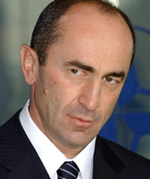Beginning in the previous ten editions
Kocharyan was re-elected president in 2003. The parliamentary elections were still ahead and they were going to decide the future of Armenian politics. Most of the Armenian mass media was under control. Although the opposition was united in one alliance, we could say that they were wiped out and/or split.
In such conditions, Kocharyan could have thought about the Lukashenko-Turkmenbash version, however there were two things bothering him – on the one hand the Armenian Diaspora, who was providing financial aid and were to some extent carriers of Western values, and on the other hand the Karabakh conflict which, in case he resolved it, Kocharyan would be forced to sit around a table with the representatives of Western civilization. The Lukashenko-Turkmenbash version predicted the arrests of the unwanted, exiles, political trials and other unpleasant things which could not have benefited Kocharyan in any way. It was necessary to make it so everybody was present, but not have everybody present; so that there would be everybody when the West watched and nobody when the people of Armenia watched.
The best version was the “melikutyun” of Karabakh and Syunik found in history textbooks. The meaning of the melikutyun is very well formulated in the “MELIK” section of the 7th volume of the Soviet Armenian Encyclopedia: “The “MELIK” (Arabic: malik-ruler, king), which is the name of Muslim rulers of Asia in the Middle Ages, was spread in Armenia in the late Middle Ages.” In this section of the encyclopedia it is said: “In 14th-18th century Iran and Eastern Armenia, meliks were also the elders of the large settlements and municipal communities who were responsible for the levying of state taxes.” The same section says that the right to be a melik in Syunik and Artsakh was confirmed by edicts of the shahs, was of inheritable character, and the melik had the rights of a monarch in his land. “The melik would hear the debates between his subjects and make a decision.”
This feudalism would be acceptable if capitalism were not more preferable. After all, early capitalism consists of all that is described in the section on feudalist meliks, but it was much stronger because it was based on the power of wealth.
The power of the state had to be converted to the power of wealth, and you would get a system where few very rich people rule the poor or, as they say nowadays, the employers rule the work force. Although the chosen ideal was capitalism, the system which was forming after the 2003 parliamentary elections was very similar to the Soviet factory in form and character, and Kocharyan had to be very familiar with the ins and outs of that system.
I will now go into detail regarding the structure of the Soviet factory for the young reader. It was headed by the manager who was appointed by the Central Committee. The manager had at least three deputy managers, and then came heads of production, whose subordinates were heads of the production units. It would be wrong to say that everything went smoothly and calmly in this system because smoothness and calmness are excluded in a place where there are goods coming in and going out. The managers with a lack of perspective distributed those goods unequally – more for them or, in the extreme case, the deputy closest to the manager, and less to rest of the members of the administration. The ones who were far-sighted let the administration members take advantage, and at the same time controlled the goods so that they could hold back the managers’ appetite and inclinations at any given time. In both cases the working class remained empty-handed.
There was something else that distinguished the far-sighted managers from those not far-sighted. The managers used to give flowers to the woman representatives of the working class on March 8th, “Polyot” watches to men for another celebration, and assignments to heads of their cafeterias for sad occasions. People thought that if they demanded better living conditions from the administration, then they would lose their flowers on March 8th, the “Polyot” watches for some celebration, the help they received from the cafeteria on sad occasions and, in the worst case scenario, their jobs.
The enforcement of the above-mentioned system started in Armenia after the 2003 parliamentary elections when the three parties that collected the most number of votes – the Armenian Republican Party, “Country of Law” and the ARF – formed the governmental coalition with the direct participation of Robert Kocharyan.
To be continued…

